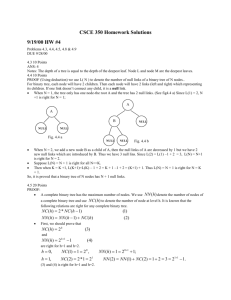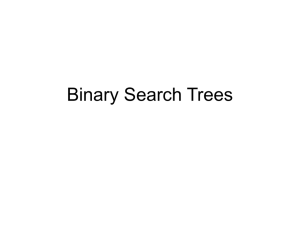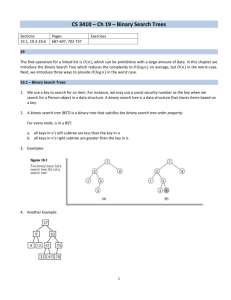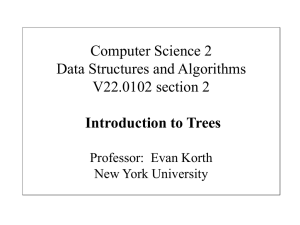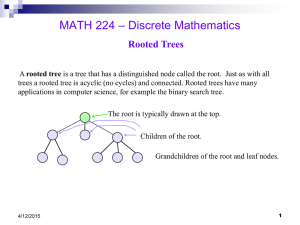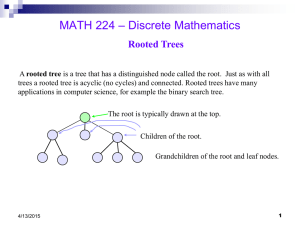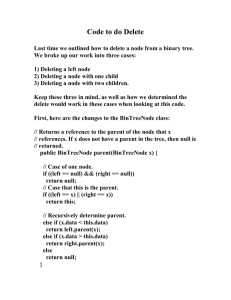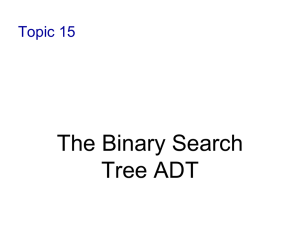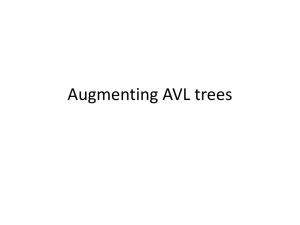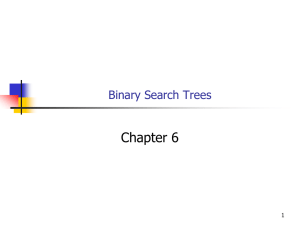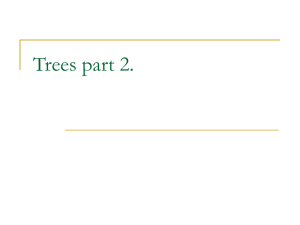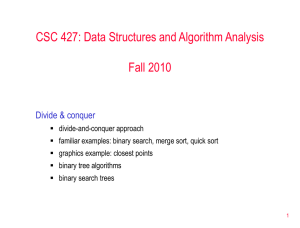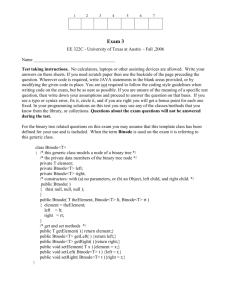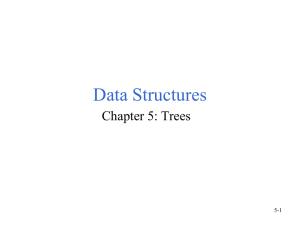Lecture 14
advertisement
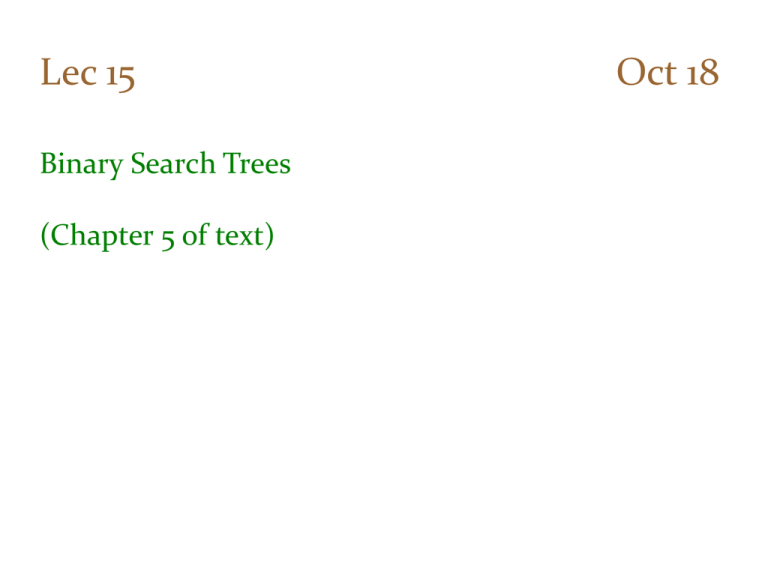
Lec 15
Binary Search Trees
(Chapter 5 of text)
Oct 18
Binary Trees
•
A tree in which no node can have more than two children
typical
binary tree
•
The depth of an “average” binary tree is considerably smaller than N,
even though in the worst case, the depth can be as large as N – 1.
Worst-case
binary tree
Node Struct of Binary Tree
Possible operations on the Binary Tree ADT
Parent, left_child, right_child, sibling, root, etc
Implementation
Because a binary tree has at most two children, we can
keep direct pointers to them
class Tree {
int key;
Tree* left, right;
}
Binary Search Trees (BST)
• A data structure for efficient searching, inser-tion
and deletion (dictionary operations)
• All operations in worst-case O(log n) time
• Binary search tree property
• For every node x:
• All the keys in its left
subtree are smaller than
the key value in x
• All the keys in its right
subtree are larger than the
key value in x
Binary Search Trees
Example:
A binary search tree
Tree height = 3
Not a binary search tree
Key requirement of a BST: all the keys in a BST are
distinct, no duplication
Binary Search Trees
The same set of keys may have different BSTs
•
•
Average height of a binary search tree is O(log N)
Maximum height of a binary search tree is O(N)
(N = the number of nodes in the tree)
Searching BST
Example: Suppose T is the tree being searched:
• If we are searching for 15, then we are done.
• If we are searching for a key < 15, then we should
search in the left subtree.
• If we are searching for a key > 15, then we should
search in the right subtree.
Search (Find)
• Find X: return a pointer to the node that has key X, or NULL
if there is no such node
Tree* find(int x, Tree* t) {
if (t == NULL) return NULL;
else if (x < t->key)
return find(x, t->left);
else if (x == t->key)
return t;
else return find(x, t->right);
}
• Time complexity: O(height of the tree) = O(log N) on
average. (i.e., if the tree was built using a random sequence
of numbers.)
Inorder Traversal of BST
• Inorder traversal of BST prints out all the keys in sorted
order
Inorder: 2, 3, 4, 6, 7, 9, 13, 15, 17, 18, 20
findMin/ findMax
Goal: return the node containing the smallest (largest) key
in the tree
Algorithm: Start at the root and go left (right) as long as
there is a left (right) child. The stopping point is the
smallest (largest) element
Tree* findMin(Tree* t) {
if (t==NULL)_return NULL;
while (t->left != NULL)
t = t->left;
return t;
}
Time complexity = O(height of the tree)
Insertion
To insert(X):
Proceed down the tree as you would for search.
If x is found, do nothing (or update some secondary
record)
Otherwise, insert X at the last spot on the path traversed
X = 13
Time complexity = O(height of the tree)
Another example of insertion
Example: insert(11). Show the path taken and the position at
which 11 is inserted.
Note: There is a unique place where a new key can be inserted.
Code for insertion
Insert is a recursive (helper) function that takes a pointer to a
node and inserts the key in the subtree rooted at that node.
void insert(int x, Tree* & t) {
if (t == NULL)
t = new Tree(x, NULL, NULL);
else if (x < t->key)
insert(x, t->left);
else if (x > t->key)
insert(x, t->right);
else ; // duplicate; do nothing
}
Deletion under Different Cases
Case 1: the node is a leaf
Delete it immediately
Case 2: the node has one child
Adjust a pointer from the parent to bypass that node
Deletion Case 3
Case 3: the node has 2 children
Replace the key of that node with the minimum element
at the right subtree
Delete that minimum element
Has either no child or only right child because if it has
a left child, that left child would be smaller and would
have been chosen. So invoke case 1 or 2.
Time complexity = O(height of the tree)
Code for Deletion
First recall the code for findMin.
Tree* findMin(Tree* t) {
if (t==NULL)_return NULL;
while (t->left != NULL)
t = t->left;
return t;
}
Code for Deletion
void remove(int x, BinaryTree* & t) {
// remove key x from t
if (t == NULL) return; // item not found; do nothing
if (x < t->key)
remove(x, t->left);
else if (x > t->key) remove(x, t->right);
else if (t->left != NULL && t->right != NULL) {
t->key = findMin(t->right)->key;
remove(t->element, t->right);
}
else {
Tree* oldNode = t;
t = (t->left != NULL) ? t->left; t->right;
delete oldNode;
}
}
Summary of BST
All the dictionary operations (search, insert and delete) as well
as deleteMin, deleteMax etc. can be performed in O(h) time
where h is the height of a binary search tree.
Good news:
h is on average O(log n) (if the keys are inserted in a random order).
code for implementing dictionary operations is simple.
Bad news:
worst-case is O(n).
some natural order of insertions (sorted in ascending or descending order)
lead to O(n) height. (check this!)
Solution:
enforce some condition on the tree structure that keeps the tree from
growing unevenly.
